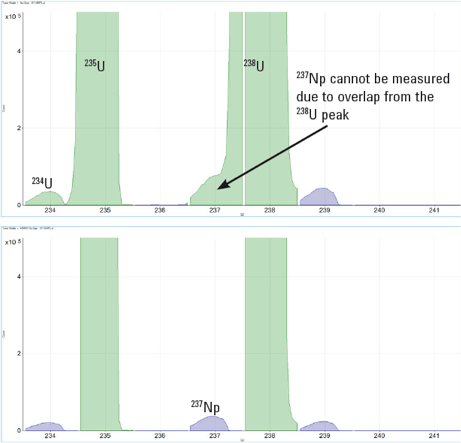Access Agilent eNewsletter October 2016

Agilent ICP-QQQ provides unique solutions for nuclear applications
Yasuyuki Shikamori and Glenn Woods
Agilent Applications Engineers
Naoki Sugiyama
Agilent ICP-MS Product Manager
Since its introduction in the mid-1980s, ICP-MS has been widely adopted by the nuclear industry due to its high sensitivity, simple mass spectra, and compatibility with conventional liquid sample introduction. More recently, Agilent triple quadrupole ICP-MS (ICP-QQQ) has expanded the range of nuclear applications to include the ultra-trace determination of nuclear indicator elements and environmental contaminants, such as iodine-129, uranium-236, and neptunium-237.
Why do analysts use ICP-QQQ for nuclear apps?
Agilent ICP-QQQ provides outstanding performance for existing nuclear applications, such as waste effluent analysis and monitoring occupational exposure. Exceptionally high matrix tolerance also enables difficult applications such as trace element analysis in reactor cooling water and uranium fuel to be performed. The tandem MS configuration of ICP-QQQ also enables new applications that utilize reaction cell methods to resolve spectral interferences. Coupled with ultra-low background noise, high sensitivity, and unrivalled abundance sensitivity, ICP-QQQ delivers low-level determinations of previously difficult elements, and separation of direct isobaric overlaps.
Challenges of trace 236U isotopic analysis
ICP-QQQ was used to measure the 236U/238U isotope ratio, which can be used to trace the accidental release of enriched uranium fuel, spent fuel, and nuclear waste. The challenge is to overcome the interference on 236U+ by the hydride ion 235UH+, and the contribution at m/z 236 from tailing of the 235U+ and 238U+ peaks. Hydride overlap and peak tailing are more problematic in samples that have been enriched, as these contain a higher proportion of 235U.
The solution: controlled reaction chemistry and access to high-mass product ion
The Agilent 8900 ICP-QQQ Advanced Applications configuration offers high sensitivity and an extended mass range to allow the measurement of uranium as the oxide (UO+) and dioxide (UO2+) reaction product ions. Uranium was measured via its dioxide ion, UO2+, due to the efficient conversion (almost 100%) of U+ to UO2+ with O2 cell gas.
This approach was successful in reducing the contribution from uranium hydride (UO2H+/UO2+) by three orders of magnitude compared to direct, on mass measurement (UH+/U+). MS/MS mode with O2 cell gas gave a hydride ratio in the 10-8 range, without the use of a desolvation system. Considering that the natural abundance of 235U is only 0.72%, our results suggest that the 235UH interference on 236U can be reduced sufficiently to allow 236U/238U measurement in the 10-10 range to be achieved using this method.
The ICP-QQQ method has the potential to allow rapid trace-level measurement of 236U/238U isotopic ratios, providing valuable information on global fallout following accidental release of nuclear material into the environment. The ultra-low instrumental background noise level and high sensitivity of the 8900 ICP-QQQ meant that a DL for uranium of 0.34 fg/g was achieved.
Analysis of neptunium 237 in the presence of uranium
Neptunium (Np) is a long-lived radio nuclide produced as a by-product of nuclear power generation. Samples that contain Np usually contain U at far higher concentrations. The determination of ultra-trace 237Np in environmental samples and nuclear materials (fuel or waste) is difficult by ICP-MS because of the overlap due to peak tailing from the large 238U peak.

Figure 1. Spectra of 100 ppt Np in a 10 ppm U matrix sample solution obtained using ICP-QQQ in Single Quad mode (top) and MS/MS mode (bottom). MS/MS mode eliminates the peak tail on the low mass side of the intense 238U peak.
The solution: superior abundance sensitivity in MS/MS mode with Agilent 8900
ICP-QQQ provides far better abundance sensitivity (peak separation) than conventional quadrupole ICP-MS due to its double mass filter. As a result, the Agilent 8900 ICP-QQQ is able to successfully separate 237Np from the 238U overlap, even when the U is present at many orders of magnitude higher concentration. This is demonstrated in Figure 1, which shows the spectra of 100 ppt Np in a 10 ppm U matrix measured in Single Quad (SQ) mode (top) and MS/MS mode below. The ICP-QQQ spectrum shows the superior peak separation provided by MS/MS mode, and the elimination of the contribution that the 238U peak makes to Np at mass 237 in Single Quad mode.
Address a wider range of applications with Agilent ICP-QQQ
The Agilent 8900 ICP-QQQ can overcome issues associated with problematic overlaps and interferences in nuclear applications. ICP-QQQ offers a unique combination of high sensitivity; low backgrounds; exceptional abundance sensitivity; controlled, effective reaction cell methods; and measurement of high mass product ions such as UO2+.
Learn how to leave interferences behind with MS/MS, then download the following Agilent publications for more details: 5991-6553EN, 5991-6905EN and 5991-0321EN.
Agilent ICP-MS Journal
Are you interested in trace metals analysis and eager to keep up-to-date with the latest developments in the field of ICP-MS? Then take a closer look at Agilent’s dedicated ICP-MS Journal. Published four times a year and available as a PDF, you can view the latest issue of the ICP-MS Journal, plus all previous copies, by visiting the ICP-MS Journal Archive.
Sign up to receive a personal copy of the ICP-MS Journal direct to your inbox.
Stay informed about the applications that are important to you
Subscribe to Access Agilent
Our free customized
monthly eNewsletter
Article Directory – October 2016
All articles in this issue
-
 Designed for true mobility—the 490-Mobile takes your lab to the sample
Designed for true mobility—the 490-Mobile takes your lab to the sample -
 Agilent 1260 Infinity II solution delivers fast, sensitive, and automated amino acid analysis
Agilent 1260 Infinity II solution delivers fast, sensitive, and automated amino acid analysis -
 Efficient analytical methods for catecholamines, metanephrines, and related metabolites in urine and plasma
Efficient analytical methods for catecholamines, metanephrines, and related metabolites in urine and plasma -
 Agilent IDP-3 Dry Scroll Pump provides clean, quiet, and reliable GC/MSD analysis
Agilent IDP-3 Dry Scroll Pump provides clean, quiet, and reliable GC/MSD analysis -
 Determination of chemical species in marine fuel oil by multidimensional GC/MS analysis
Determination of chemical species in marine fuel oil by multidimensional GC/MS analysis -
 Tip: Easily transfer Agilent GC/MSD methods to Agilent triple quadrupole GC/MS systems
Tip: Easily transfer Agilent GC/MSD methods to Agilent triple quadrupole GC/MS systems -
 Agilent ICP-QQQ provides unique solutions for nuclear applications
Agilent ICP-QQQ provides unique solutions for nuclear applications
Figure 1

Spectra of 100 ppt Np in a 10 ppm U matrix sample solution obtained using ICP-QQQ in Single Quad mode (top) and MS/MS mode (bottom). MS/MS mode eliminates the peak tail on the low mass side of the intense 238U peak.